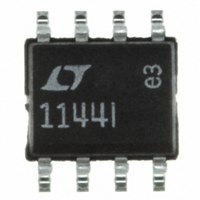LTC1144IS8#PBF Linear Technology, LTC1144IS8#PBF Datasheet - Page 6

LTC1144IS8#PBF
Manufacturer Part Number
LTC1144IS8#PBF
Description
IC VOLT CONV SW-CAP W/SHTDN8SOIC
Manufacturer
Linear Technology
Type
Switched Capacitor (Charge Pump), Invertingr
Datasheet
1.LTC1144CS8PBF.pdf
(8 pages)
Specifications of LTC1144IS8#PBF
Internal Switch(s)
Yes
Synchronous Rectifier
No
Number Of Outputs
1
Current - Output
50mA
Frequency - Switching
4kHz ~ 10kHz
Voltage - Input
2 ~ 18 V
Operating Temperature
-40°C ~ 85°C
Mounting Type
Surface Mount
Package / Case
8-SOIC (3.9mm Width)
Power - Output
500mW
Primary Input Voltage
18V
No. Of Outputs
1
Output Voltage
-18V
No. Of Pins
8
Operating Temperature Range
-40°C To +85°C
Msl
MSL 1 - Unlimited
Power Dissipation Pd
500mW
Rohs Compliant
Yes
Lead Free Status / RoHS Status
Lead free / RoHS Compliant
Voltage - Output
-
Available stocks
Company
Part Number
Manufacturer
Quantity
Price
A
LTC1144
and hence the efficiency, is set by the output impedance.
As frequency is decreased, the output impedance will
eventually be dominated by the 1/(f C1) term and power
efficiency will drop.
Note also that power efficiency decreases as frequency
goes up. This is caused by internal switching losses which
occur due to some finite charge being lost on each
switching cycle. This charge loss per unit cycle, when
multiplied by the switching frequency, becomes a current
loss. At high frequency this loss becomes significant and
the power efficiency starts to decrease.
SHDN (Pin 6)
The LTC1144 has a SHDN pin that will disable the internal
oscillator when it is pulled low. The supply current will also
drop to 8 A.
OSC (Pin 7) and Boost (Pin 1)
The switching frequency can be raised, lowered or driven
from an external source. Figure 6 shows a functional
diagram of the oscillator circuit.
By connecting the boost pin (pin 1) to V
discharge current is increased, and hence the frequency is
increased by approximately 10 times. Increasing the fre-
quency will decrease output impedance and ripple for
higher load currents.
Loading pin 7 with more capacitance will lower the fre-
quency. Using the boost (pin 1) in conjunction with exter-
6
PPLICATI
Figure 5. Power Conversion Efficiency and Output
Resistance vs Oscillator Frequency
100
95
90
85
80
75
70
0.1
V
I
L
+
= 20mA, T
= 15V, C1 = C2 = 10 F
O
OSCILLATOR FREQUENCY (kHz)
U
S
A
1
= 25°C
I FOR ATIO
U
CONVERSION
EFFICIENCY
POWER
RESISTANCE
OUTPUT
10
W
1144 F05
+
, the charge and
100
600
500
400
300
200
100
0
U
nal capacitance on pin 7 allows user selection of the
frequency over a wide range.
Driving the LTC1144 from an external frequency source
can be easily achieved by driving pin 7 and leaving the
boost pin open as shown in Figure 7. The output current
from pin 7 is small, typically 4 A, so a logic gate is capable
of driving this current. The choice of using a CMOS logic
gate is best because it can operate over a wide supply
voltage range (3V to 15V) and has enough voltage swing
to drive the internal Schmitt trigger shown in Figure 6. For
5V applications, a TTL logic gate can be used by simply
adding an external pull-up resistor (see Figure 7).
Capacitor Selection
External capacitors C1 and C2 are not critical. Matching is
not required, nor do they have to be high quality or tight
tolerance. Aluminum or tantalum electrolytics are excellent
choices, with cost and size being the only consideration.
C1
+
NC
BOOST
GND
(1)
(3)
1
2
3
4
REQUIRED FOR
LTC1144
Figure 7. External Clocking
Figure 6. Oscillator
9I
TTL LOGIC
9I
V
8
7
6
5
+
I
I
1144 F06
+
100k
–(V
C2
+
)
20pF
OSC
(7)
V
+
SCHMITT
TRIGGER
OSC INPUT
1144 F07











